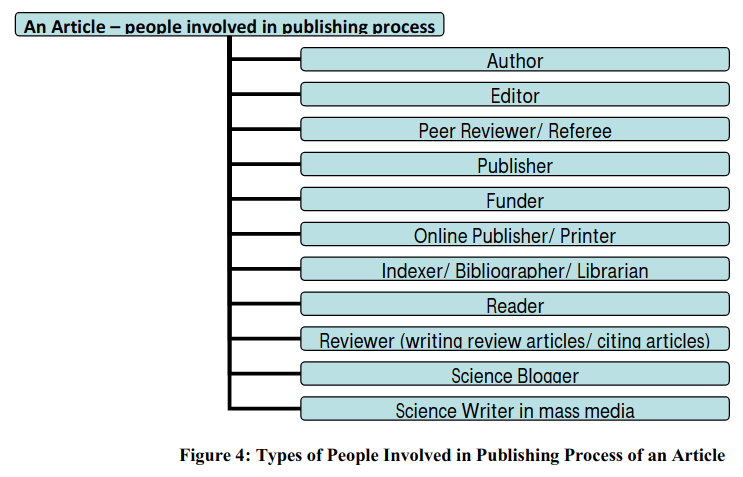2.2 Academic Journals, Their Functions, Working and Procedures
As indicated in the previous Unit, the academic journals are the most preferred channel of scholarly communication for publishing primary research results. After the World War II, the world saw a sharp rise of scholarly research –mostly funded by the public funded research councils around the world, more specifically in developed nations. Many developing countries as well as emerging countries within the group of developing nations have also undertaken capability enhancement drive in the last three decades to establish research and development (R&D) centres in those countries in collaboration with research institutions in advanced countries. There is also sharp rise in North-South scientific cooperation for technical and intellectual capability development in countries in the global South. All these efforts have resulted in higher production of scholarly literature and publishing them in scientific journals and other media for worldwide dissemination. Most of academic journals are published by non-profit publishers such as learned societies, research councils, research institutions, university presses, research and literary academies. On the other hand, in the twentieth century we see that for-profit publishers such as publishing companies and multinational enterprises are taking great interests in publishing academic journals, usually in collaboration with learned societies. In a recent study, it has been revealed that for-profit publishers Elsevier, Springer and Wiley now have a large market share – about 42% of journal articles in STM (Science, Technology and Medicine) disciplines. They also have made high profit margins in recent years – between 30% to 40% – by charging high subscription fees as well as open access publishing fees. Thus, STM journal publishing has gone into the hands of monopolistic corporations. However, non-profit academic publishing ventures are also flourishing due to easy availability of electronic publishing (or e-publishing) avenues and more particularly open access channels for achieving universal and free dissemination of scholarly literature, global authorship and global readership of journal contents. Academic journals also have continued practices of peer reviewing of submitted manuscripts before publishing. For inclusion in renowned citation databases such as Web of Science8 (WoS) and Scopus, or in subject-specific indexing & abstracting (I&A) services, an academic journal should meet the following main eligibility criteria:
i) have a ISSN number,
ii) should consist of peer-reviewed contents;
iii) should be published on a regular basis;
iv) the contents should be relevant and readable for an international audience, and
v) should have a publication ethics and publication malpractice statement.
These eligibility criteria are drawn from Scopus’ Content Policy and Selection Criteria9. This is more or less similar in other international I&A services and citation databases. A scholarly paper, also known as an article, is an independent academic piece of writing where an original study has been presented with scientific evidences and analytical reasoning. Figure 4 depicts persons involved in publishing process of an article. A published article is a collaborative piece of academic writing, where many persons – both visible and invisible – have significant contributions in pre-publishing and post-publishing processes. An author is solely, legally and morally responsible for creation and submission of a scholarly paper. The paper can also have multiple co-authors, who are involved in the research study and deriving research results. There is also possibility of having informal contributions of some professional colleagues or peers of authors – who have helped in developing a particular manuscript in draft stage with their valuable comments or critical feedbacks. After submission of a manuscript to an academic journal, a paper usually goes to a journal editor or an editorial board member. If editor agrees with suitability of the submitted manuscript to journal’s scope and subject coverage, the paper is sent to one or two peer reviewers along with guidelines for the reviewers. Peer reviewers are subject experts and senior researchers with considerable publishing experiences. They advise the editor on acceptance, rejection or revision of the submitted manuscript. In the publishing process publisher, printer, online publisher and few other people are involved for making the article available in print or online format. A funder or funding agency has supported the research study – a research paper is an outcome of that research study. Sometimes funder supports a publishing fee or article processing charge (APC), if required, for publishing an open access article in hybrid or open access journal. A hybrid journal publishes both open access articles and restricted access articles meant for subscribers of that journal, whereas an open access journal publishes open access articles only. In post-publishing process, the indexers, bibliographers and librarians are involved in making a research paper known and accessible to research communities through various information, alerting and reference services. Then a paper is accessed by a reader who is a current researcher – actively involved in academic study, teaching or research. The person could be a reviewer of the published paper and can cite this paper in forthcoming review article or research paper. Sometimes, an academic paper gets immediate media attention due to revealing some interesting facts, or conveying important social messages. Science bloggers and science writers in mass media highlight interesting findings in a research paper. Newspapers and magazines portray many such stories to keep abreast their readers on latest innovations and scientific development around the world. Thus, a research article has many collaborators – active or passive – to facilitate knowledge transmission from one to many, from lab to industry, field to fork.

